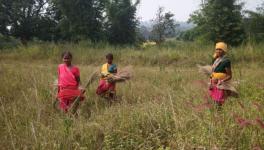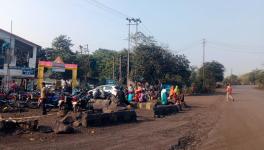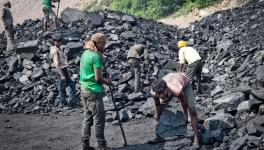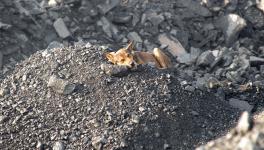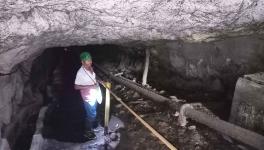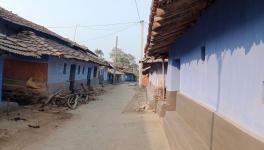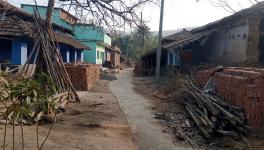No Rehab in Sight, Thousands Live in Areas Made Vulnerable by Mining in Bengal’s Raniganj Coalfields
All that remains of the dilapidated house of Tapan Pal in Harishpur village of Paschim Bardhaman following an incident of earth subsidence in July 2002
Paschim Bardhaman: More than 12 years after a grandiose plan was formulated to resettle habitations affected by land subsidence incidents in the Raniganj coalfields of West Bengal, thousands of families continue to live in areas that could collapse any moment subsuming their lives and properties. As is evident on the ground, a political conflict over land has further worsened the fate of those living in areas rendered void by underground coal mining and subsequent sub-terranean fires.
Eastern Coalfields Limited (ECL), a subsidiary of the Centrally-owned public sector major Coal India Limited, which owns the collieries in Raniganj, alleges tardy work by the state government in rehabilitating the mining-affected families.
On the other side, the state government alleges that land identified for the proposed housing colonies is not being made available readily by ECL to Asansol-Durgapur Development Authority (ADDA), the nodal agency for resettlement. The ADDA passes the buck to the West Bengal housing department, which is in-charge of constructing houses, blaming it for the slow pace of development work. Furthermore, government agencies blame local residents of the mining-affected villages for their alleged unwillingness to resettle elsewhere.
Numerous earth subsidence incidents have occurred in villages of Paschim Bardhaman district, but very sizeable sections of population continue to reside in houses rendered dilapidated by these events. Local residents in Harishpur, a village in Andal block of the district, allege that the fragile terrain notwithstanding, ECL went ahead with an open cast mining project in close proximity to human habitations, in the adjacent Madhabpur colliery.
“Further, the size of the mining pit kept growing over the years and expanded toward our habitation. When activities like dynamite blasting and breaking down of rocks, using heavy equipment, was carried out in close proximity to our houses, the land over which we reside began to subside. A number of high-transmission electricity towers also collapsed in the process, which had to be later replaced,” says Tapas Gop (39), a local resident.
Krishna Mondal (65), a retired government employee from Harishpur, recounted how the mining area kept expanding till it came dangerously close to a local government primary school. There is a gap of hardly 100 metres between the school’s main building and the edge of the mining pit. A portion of the school’s football field, outside its boundary wall, has also collapsed into the pit.
A Hindi medium primary school in Harishpur village of Paschim Bardhaman which has been permanently closed after earth subsidence incidents rendered the building unsafe
“During dynamite blasting, stone pieces used to rain over the school premises, even as kids would be in classes. Finally, the school was shut down because the building was rendered unsafe due to mining. Our kids do not have a place to study, and there is no government plan either for another school,” says Mondal.
Not only school kids, but large sections of population living in this region complained of having suffered the worst of environmental pollution when coal was mined a few hundred metres away from the habitations. They complained of having developed long-term respiratory ailments from fugitive dust before mining operations were suspended. Another Hindi-medium primary school, as well as a single-roomed building which was earlier used as an ICDS (anganwadi and mid-day meal) centre, have also shut down after cracks developed on their walls.
Madhabpur colliery near Harishpur falls in an area designated by ECL as Kajora. Two major back-to-back subsidence incidents had hit Harishpur in July 2020, damaging nearly 25 houses and forcing the families living there to flee. In the absence of government rehabilitation, these families have been forced to live in rented accommodations elsewhere.
These incidents also led to loss of livelihoods in the village. A teashop belonging to Dayamoy Choudhury (45), located on the main road leading into the village, closed down permanently because the hut in which he carried out his business could collapse any moment. Diwakar Gop (42) has been unemployed ever since the roof of his garage collapsed in the subsidence events of July 2020. A couple of vans got damaged during the incident resulting in further losses for Gop. A one-roomed tiled house used by local Trinamool Congress workers for their party activities also collapsed in the subsidence.
Residents recall with horror how a two-storied building belonging to one Tapan Pal collapsed like a pack of cards one night in July 2020. The ground floor was completely decimated, while the upper floor, which collapsed upon it, still stands testimony to the subsidence incident. The inhabitants of the house had a narrow escape as they had evacuated just a couple of hours earlier, after the walls developed cracks.
Pal relocated with his family to a rented accommodation in nearby Gopalmath. His cousin Ujwal, who lived in an adjoining portion of the same building, relocated with his family to an old staff quarter of ECL which was offered at that time for immediate resettlement. Another cousin, Amar Baran Pal (63), continues to live in his portion of the extended dilapidated house along with his 20-year-old son, who is wheelchair-bound because of full disability.
“The quarters offered by ECL were not livable. They were old. They had been abandoned several years ago. These quarters were earlier used by ECL workers and were called “restrooms”. The only facility there is availability of piped water. We continue to live in our dilapidated houses despite the fact that even potable water is not available here due to the breakdown of pipelines from earth subsidence,” Pal told NewsClick.
On the day this correspondent visited Harishpur, women of the village were busy in preparations for the marriage ceremony of the eldest daughter of a local resident Bhagirath Choudhary (60). The women were decked up in fineries for the occasion but only very few relatives of the groom’s family had been invited to the village for traditional rituals held prior to a Bengali marriage ceremony.
“We could only procure a limited quantity of water for the rituals with the help of tankers. Hence, we invited limited number of guests. Besides, the local Durga temple and community house, where rituals are being conducted, are also dilapidated and stand the risk of collapse any moment,” said Deepali Choudhary (55), a member of the bride’s family.
The rear part of the village resembled a haunted place with more than two dozen dilapidated houses which have been abandoned. Further down the road was a habitation of around 60 tribal families, who unlike the rest of the village, do not have land ownership records despite the fact that their ancestors had settled in the region several centuries ago. This habitation, Majhipara, is closer to the mining pit as compared to the rest of Harishpur.
“The entire area over which our habitations are located has subsided below the level of the road. A common well got subsumed within the mining pit, leaving us with no source of drinking water. The miners did not even spare our community temple which we called Majithan,” Chundki Tudu, an 80-year-old woman from Majhipara told the Newsclick.
Habitants of this tribal settlement allege their Majithan was destroyed in an incident of dynamite blasting in the colliery when mining activities began to be conducted beyond safe limits. The place where the Majithan stood is now filled with water and is used by the tribal families for their daily needs in the absence of potable water supply.
The dwelling units in Majhipara are mud structures with tiled roofs that are most susceptible to collapse from subsidence. In the absence of land ownership records, the habitants of Majhipara are not convinced they will be provided accommodation in the any of the resettlement colonies ever. A few families have, however, shifted to the ECL “restrooms” which were never occupied by non-tribal families of Harishpur.
When contacted by NewsClick, Jayesh Chandra Rai, general manager of ECL Kajora Area, denied that mining operations in Madhabpur colliery were ever conducted beyond designated limits.
“We are a government agency and have to abide by the rules while conducting mining operations. The periphery of each mining project is clearly marked by the Directorate General of Mines Safety and inspections are conducted regularly. As a government subsidiary, we cannot mine beyond the area leased out to us and recorded in the environmental clearance. Land subsidence is only because of unscientific underground mining practices before nationalisation of the coal sector in 1971,” said Rai.
Since May 2020, mining operations have been discontinued in Madhabpur colliery, nearly two months before the subsidence incidents of July that year, after it was discovered that there were hardly any reserves left within the excavated pit. Though ECL tried to acquire private land of Harishpur to expand mining operations, these efforts were stonewalled by land owners.
It has been claimed by ECL that surface fires at all seven locations spread over an area of 755 hectares, which were identified in the Raniganj Master Plan of 2009, have been doused. Allegations of illegal mining in Kajora, which has eight operational underground mines and one open cast mine, were denied by ECL as has been alleged by several political parties in the past.
In the run-up to the West Bengal Assembly elections of May 2021, there was a bitter political slugfest with activists and leaders of the ruling Trinamool Congress in the state blaming the Bharatiya Janata Party-led Central government for delay in handing over land identified by the incumbent Mamata Banerjee government for resettling mining-affected families of Raniganj coalfields. The village of Harishpur boycotted the Assembly polls altogether: not a single vote was cast.
“We can hand over only those parcels of land which do not have mineable reserves of coal. And it is for the Central Mine Planning and Design Institute to decide as to which lands are coal-bearing. Land availability is not an issue. In the recent past, we had even cleared a large parcel of land where a new airport has been built in Andal,” said Rai.
The West Bengal government had identified 362.5 acres for construction of housing colonies following an interim survey by ADDA, as per which 28,991 families in Raniganj needed resettlement. Out of this, ECL has so far handed over only 146.9 acres to the state’s housing department at four resettlement sites. The housing department has undertaken construction work on 10,144 flats out of an approved total of 12,976 units, in accordance with the Raniganj Master Plan of 2009. The implementation period of the Master Plan has already expired in 2019.
“In the last week of November last year, allotment letters were issued by ADDA to 137 families of Chhatim Danga in Paschim Bardhaman district for new flats in a resettlement colony in Bijaynagar. The revalidation process of the new Master Plan is underway. At the end of the day, ADDA is only a nodal agency for the resettlement project. Land will be made available by ECL while construction will be carried out by the housing department,” Manash Kumar Panda, ADDA’s assistant executive officer, told NewsClick.
The writer is an independent journalist.
Get the latest reports & analysis with people's perspective on Protests, movements & deep analytical videos, discussions of the current affairs in your Telegram app. Subscribe to NewsClick's Telegram channel & get Real-Time updates on stories, as they get published on our website.









